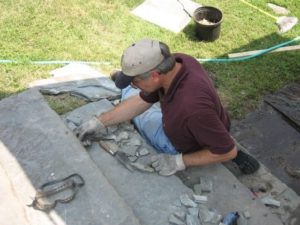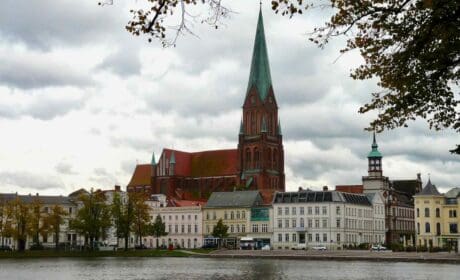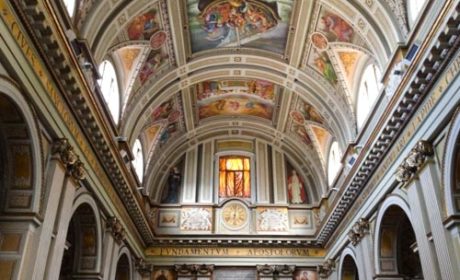When Jamie Donahoe of Adventures in Preservation contacted me about her company’s unique volunteer vacations, I knew it was something that our baby boomer readers would enjoy learning about. If you’re a boomer who’s interested in travel, history and architectural preservation, these trips are for you. In today’s guest post, Jamie describes what it’s like to go on an Adventures in Preservation vacation.

Itchy feet are one thing, but what if your hands are itching to do something, too? I’ve found volunteer vacations to be a perfect solution. There are many ways to give back to this great world of ours; but since one of my primary travel interests is combining history and architecture (though I don’t pass up a good beach or hiking vacation either), I’ve found an adventure in preservation to be the perfect antidote for those itches.
Joining the aptly named non-profit Adventures in Preservation (AiP) on several projects, I have re-pointed historic masonry, learned first-hand how a timber frame structure is put together and practiced – though not mastered – the fine art of galleting. Along the way, I’ve met great people, enjoyed some fabulous Southern cooking and contributed in meaningful ways to the preservation and restoration of historic buildings and structures.
AiP’s preservation vacations offer baby boomers a different way to travel, in that the group is made up of volunteers who have come from afar and volunteers from the local community. This interaction gives you a chance to really get to know the people whose heritage you’re preserving. I still keep in touch with people I met at workshops.
Our projects focused on a specific part of the restoration process (which in many cases is a multi-year endeavor), and everyone found something to do that suited their interests and abilities. Those without any related experience, learned; those with experience and expertise, shared. Several women at the Francis Mill workshop had never used power tools before; by the end of the week, they were sawing up a storm.
AiP provided a technical expert who led each workshop, teaching and guiding us as we worked. The experts were fonts of knowledge, and it was fascinating to learn from them. At the Bartow-Pell workshop, Andy deGruchy wanted us to each try drilling a hole – by hand – through stone. It was his way of underscoring just how much labor is embodied in historic masonry buildings and why he is prepared to stand in front of bulldozers to preserve them. (None of us actually finished a hole!)

Galleting was something I’d never even heard of. Turns out it’s a masonry finishing method which entails setting small stones, or gallets, in the joints between stones. The resulting effect is very natural looking, and for that reason it was the finish used in the original 1915 terrace garden design at the Bartow-Pell Mansion Museum, Bronx, New York. Through the years, as gallets worked their way loose, and the paving stones shifted, workers used concrete to repair the steps and walkways, creating a completely different feel to the garden.
Our work also involved hacking out the concrete, which was very labor intensive, particularly in the hot August sun. After four full days of work, we had finished the first section of the garden and were amazed how visible the difference was. Volunteers have returned to tackle an additional section of the garden each year; August 2010 will be the third year; the final section is scheduled for 2011.
Preservation can be a long process and while we did just one part, it was a great feeling knowing that our work will be evident for many years. Similarly, my week at the Francis Mill in Waynesville, North Carolina, was just about the most satisfying thing I’ve ever done. For two weeks in 2004, volunteers worked feverishly to repair the lower floor framing of the heavily deteriorated, 1887 water-powered grist mill, learning how to make mortises, tenons and Dutchman repairs as well as other aspects of timber frame restoration. In the last hour, of the last day, with the help of a donated boom crane, we slipped the new 26’ hemlock sill beam into place – absolutely incredulous at what we had accomplished. That evening, we enjoyed a delicious BBQ that a local restaurant donated as a way of participating, too. Each person volunteering there that year had plenty to be proud of. We laid the groundwork for three more years of restoration work, the majority of which was done by volunteers. Today the mill is fully operational and is host to student groups, an annual music festival, and the Cold Mountain History Tour. I went back to visit the mill last summer and saw water rush down the flume and turn the new water wheel. Our sill beam is still solidly in place, supporting the building.
Disclosure: This is not a paid or sponsored post. Jamie offered solid information about traveling on a volunteer architectural preservation vacation that we thought our baby boomer readers would enjoy.
Have you traveled on a volunteer vacation? Join the conversation at the My Itchy Travel Feet page on Facebook or send us an email to ask a question or share your experience.


